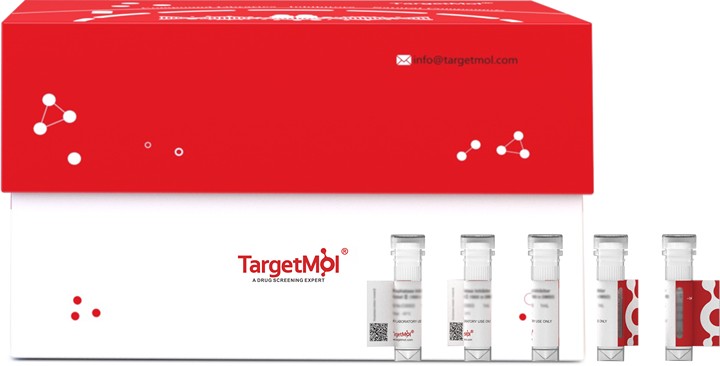- Remove All
 Your shopping cart is currently empty
Your shopping cart is currently empty
MGAT3 Protein, Mouse, Recombinant (His & Myc)
It is involved in the regulation of the biosynthesis and biological function of glycoprotein oligosaccharides. Catalyzes the addition of N-acetylglucosamine in beta 1-4 linkage to the beta-linked mannose of the trimannosyl core of N-linked sugar chains, called bisecting N-acetylglucosamine (GlcNAc). It is one of the most important enzymes involved in the regulation of the biosynthesis of glycoprotein oligosaccharides. The addition of this bisecting GlcNAc residue alters not only the composition, but also the conformation of the N-glycan. The introduction of the bisecting GlcNAc residue results in the suppression of further processing and elongation of N-glycans, precluding the formation of beta-1,6 GlcNAc branching, catalyzed by MGAT5 since it is unable to use the bisected oligosaccharide as a substrate. Addition of bisecting N-acetylglucosamine to CDH1/E-cadherin modulates CDH1 cell membrane location. Inhibits NeuAc-alpha-2,3-Gal-beta-1,4-GlcNAc- formation which modulates sialylation levels and plays a role in cell migration regulation. In brain, addition of bisecting N-acetylglucosamine to BACE1 blocks its lysosomal targeting in response to oxidative stress and further degradation which increases its location to early endosome and the APP cleavage.

MGAT3 Protein, Mouse, Recombinant (His & Myc)
| Pack Size | Price | Availability | Quantity |
|---|---|---|---|
| 20 μg | $360 | 20 days | |
| 100 μg | $745 | 20 days | |
| 1 mg | $2,530 | 20 days |
Product Information
| Biological Activity | Activity has not been tested. It is theoretically active, but we cannot guarantee it. If you require protein activity, we recommend choosing the eukaryotic expression version first. |
| Description | It is involved in the regulation of the biosynthesis and biological function of glycoprotein oligosaccharides. Catalyzes the addition of N-acetylglucosamine in beta 1-4 linkage to the beta-linked mannose of the trimannosyl core of N-linked sugar chains, called bisecting N-acetylglucosamine (GlcNAc). It is one of the most important enzymes involved in the regulation of the biosynthesis of glycoprotein oligosaccharides. The addition of this bisecting GlcNAc residue alters not only the composition, but also the conformation of the N-glycan. The introduction of the bisecting GlcNAc residue results in the suppression of further processing and elongation of N-glycans, precluding the formation of beta-1,6 GlcNAc branching, catalyzed by MGAT5 since it is unable to use the bisected oligosaccharide as a substrate. Addition of bisecting N-acetylglucosamine to CDH1/E-cadherin modulates CDH1 cell membrane location. Inhibits NeuAc-alpha-2,3-Gal-beta-1,4-GlcNAc- formation which modulates sialylation levels and plays a role in cell migration regulation. In brain, addition of bisecting N-acetylglucosamine to BACE1 blocks its lysosomal targeting in response to oxidative stress and further degradation which increases its location to early endosome and the APP cleavage. |
| Species | Mouse |
| Expression System | E. coli |
| Tag | N-10xHis, C-Myc |
| Accession Number | Q10470 |
| Amino Acid | HFFKTLSYVTFPRELASLSPNLISSFFWNNAPVTPQASPEPGDPDLLRTPLYSHSPLLQPLSPSKATEELHRVDFVLPEDTTEYFVRTKAGGVCFKPGTRMLEKPSPGRTEEKTEVSEGSSARGPARRPMRHVLSSRERLGSRGTRRKWVECVCLPGWHGPSCGVPTVVQYSNLPTKERLVPREVPRRVINAININHEFDLLDVRFHELGDVVDAFVVCDSNFTAYGEPRPLKFREMLTNGTFEYIRHKVLYVFLDHFPPGGRQDGWIADDYLRTFLTQDGVSRLRNLRPDDVFIIDDADEIPARDGVLFLKLYDGWTEPFAFHMRKSLYGFFWKQPGTLEVVSGCTMDMLQAVYGLDGIRLRRRQYYTMPNFRQYENRTGHILVQWSLGSPLHFAGWHCSWCFTPEGIYFKLVSAQNGDFPRWGDYEDKRDLNYIRSLIRTGGWFDGTQQEYPPADPSEHMYAPKYLLKNYDQFRYLLENPYREPKSTVEGGRQNQGSDGRSSAVRGKLDTAEG |
| Construction | 24-538 aa |
| Protein Purity | > 85% as determined by SDS-PAGE. |
| Molecular Weight | 66.6 kDa (predicted) |
| Endotoxin | < 1.0 EU/μg of the protein as determined by the LAL method. |
| Formulation | If the delivery form is liquid, the default storage buffer is Tris/PBS-based buffer, 5%-50% glycerol. If the delivery form is lyophilized powder, the buffer before lyophilization is Tris/PBS-based buffer, 6% Trehalose, pH 8.0. |
| Reconstitution | Reconstitute the lyophilized protein in sterile deionized water. The product concentration should not be less than 100 μg/mL. Before opening, centrifuge the tube to collect powder at the bottom. After adding the reconstitution buffer, avoid vortexing or pipetting for mixing. |
| Stability & Storage | Lyophilized powders can be stably stored for over 12 months, while liquid products can be stored for 6-12 months at -80°C. For reconstituted protein solutions, the solution can be stored at -20°C to -80°C for at least 3 months. Please avoid multiple freeze-thaw cycles and store products in aliquots. |
| Shipping | In general, Lyophilized powders are shipping with blue ice. Solutions are shipping with dry ice. |
| Research Background | It is involved in the regulation of the biosynthesis and biological function of glycoprotein oligosaccharides. Catalyzes the addition of N-acetylglucosamine in beta 1-4 linkage to the beta-linked mannose of the trimannosyl core of N-linked sugar chains, called bisecting N-acetylglucosamine (GlcNAc). It is one of the most important enzymes involved in the regulation of the biosynthesis of glycoprotein oligosaccharides. The addition of this bisecting GlcNAc residue alters not only the composition, but also the conformation of the N-glycan. The introduction of the bisecting GlcNAc residue results in the suppression of further processing and elongation of N-glycans, precluding the formation of beta-1,6 GlcNAc branching, catalyzed by MGAT5 since it is unable to use the bisected oligosaccharide as a substrate. Addition of bisecting N-acetylglucosamine to CDH1/E-cadherin modulates CDH1 cell membrane location. Inhibits NeuAc-alpha-2,3-Gal-beta-1,4-GlcNAc- formation which modulates sialylation levels and plays a role in cell migration regulation. In brain, addition of bisecting N-acetylglucosamine to BACE1 blocks its lysosomal targeting in response to oxidative stress and further degradation which increases its location to early endosome and the APP cleavage. |
Dose Conversion
Calculator
Tech Support
Keywords

Copyright © 2015-2025 TargetMol Chemicals Inc. All Rights Reserved.


